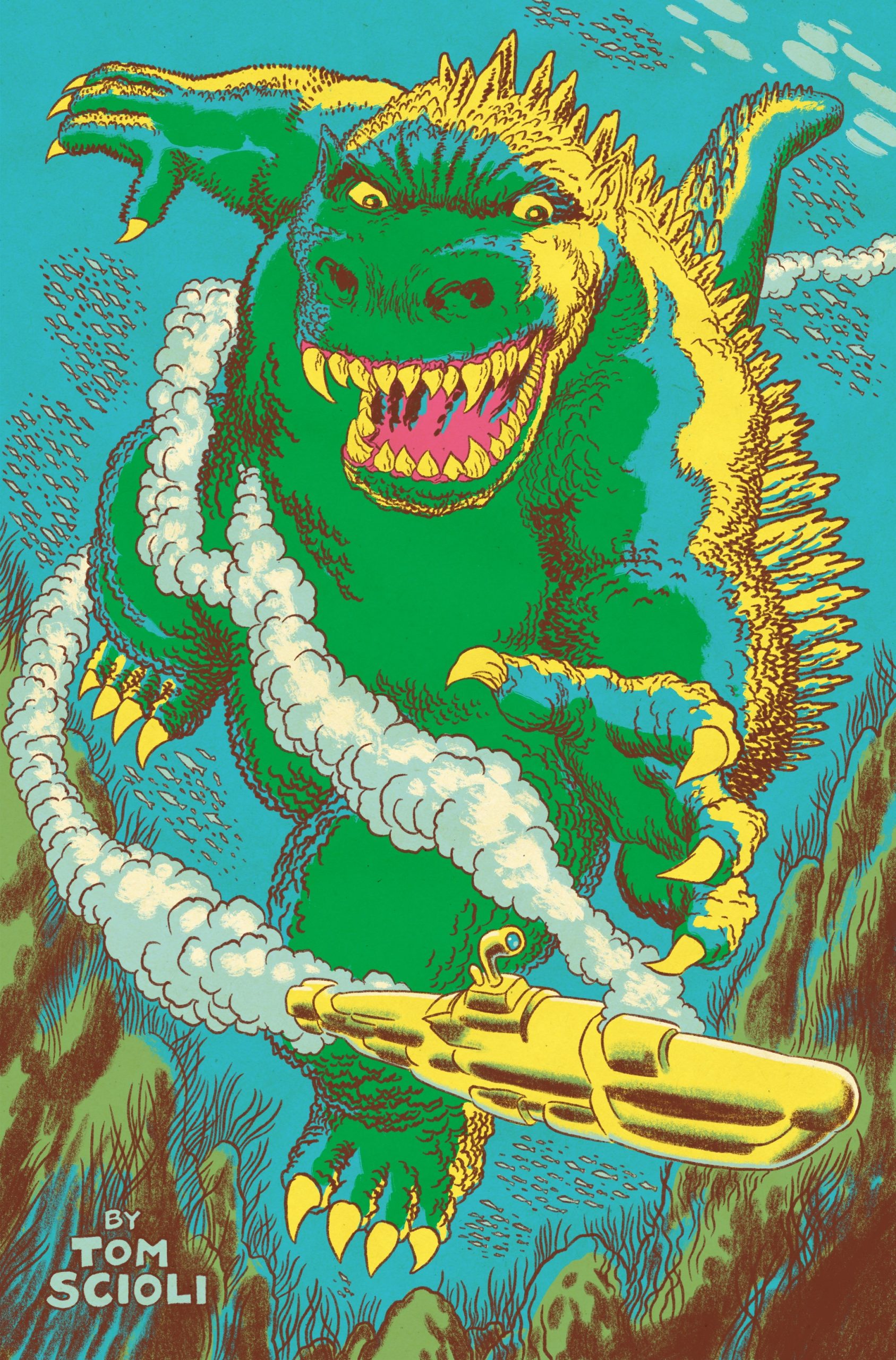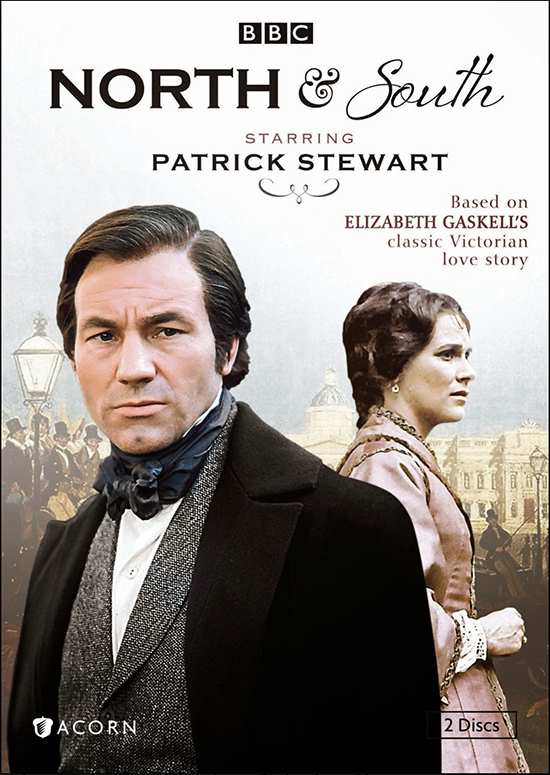THE GREAT… GASKELL?
By:
December 18, 2024
One in a series of occasional detours from Adam McGovern’s irregularly scheduled column OFF-TOPIC.

If you’re never quite sure what holiday card could possibly embody what you want to express, and tend to be suspect of the whole industry of pre-composed sentiment, it could be that both outlooks will be best satisfied by curling up with 40+ pages of city-leveling carnage and pyrotechnic vengeance. Godzilla’s Monsterpiece Theatre by writer-artist Tom Scioli (assisted by F. Scott Fitzgerald) is a new holiday classic (debuting this past Halloween and back today right before Christmas, which I’m hoping places Valentine’s Day right in its path next time) in which everyone’s favorite walking natural disaster runs afoul of Jay Gatsby, who finds new purpose hunting the creature after it destroys his beachside estate. The quest indiscriminately tramples across history and fantasy as it does literature and pulp, with Gatsby crossing paths with the likes of Thomas Edison and Jules Verne and drawing everyone from Sherlock Holmes to H.G. Wells’ time-traveler (to maybe Dracula?) to his cause. Scioli and I spoke in October about the first of GMT’s three issues, with the less-Halloween-y aspects of our Q&A thrown off like jagged shards of comic-history and compositional process that we swore we’d return to survey. The intriguingly twisted remains lay before you…:
HILOBROW: What brought you to this book — we talked about your longstanding fascination with Godzilla, did the publisher say “would you like to do a Godzilla book,” or were you looking around for one… or even for a Gatsby book to do, because the meticulousness with which you’ve remixed the text speaks to me of somebody who maybe has read the book 1,500 times!
SCIOLI: It does feel like a merging of a bunch of different projects that I’ve been working on; I never proposed a Gatsby adaptation, but I was interested in and did pitch different classical novel adaptations; I’d also been working on a Sherlock Holmes project… so those other threads seemed to find their way into this. I got it in my head that I really really wanted to do a Godzilla comic, and I went to them. It ended up being an ongoing conversation, a couple different pitches, and we ended up here.
HILOBROW: Did any of the classic literature ideas come from their end, or you just thought, “what do I have laying around that’s in an in-progress form”?
SCIOLI: The classic literature stuff was ideas I was considering for Ten Speed, the publisher of the Jack Kirby and the Stan Lee books, because they’re owned by Penguin Random House so they have access to certain texts. And I was thinking about doing like, an Elizabeth Gaskell adaptation, and a couple different things. But I did like this idea of getting literary and getting way out of traditional comic — or at least the kinds of comics I’ve worked on, the action-adventure kind of stuff, getting way out of that… although I guess those are kind of traditional comics too, because [of] Classics Illustrated — they sold a lot of those!
HILOBROW: It is kind of redeeming Classics Illustrated, because somehow I have more of a consciousness of Fitzgerald’s prose in this kind of context than I would in something that was dried-out and just a frame-by-frame illustration of Gatsby, I get the flavor of it more.
SCIOLI: Yeah, and Fitzgerald’s writing compared to some of the older things, his was pretty modern, pretty fast, it just kinda gets you from here to there, and the language is really interesting, it’s very modern writing. Although, thinking about Elizabeth Gaskell’s writing is kind of like that too; she didn’t write like Dickens or someone; she wrote where you’d read a paragraph and like a lifetime has gone by; the things described in this paragraph are years’ worth of stuff, her prose moves at a pretty fast clip too.
HILOBROW: Will Fitzgerald’s text continue to be the main frame of the other two issues? If that’s not spoiling!
SCIOLI: Less so in subsequent issues, it does pop up here and there, but it’s probably at its height in this first issue.
HILOBROW: As we get ripped out of the original!
SCIOLI: Right, as we get further and further from the source material with each turn of the page.
HILOBROW: It’s gotten rare — though I guess more possible — for examples of the comics genre that mixes historic and literary figures with genre fantasy to stand out, as I think this one completely does… there’s such a wide fabric of these that there will be some great ones…
SCIOLI: I think one thing that makes it stand out — and from comics in general — is the readability of it. I designed it to… I really had a breakthrough with the I Am Stan biography of just how to make a comic… like butter. Make it read in a really fun, pleasurable, effortless way. Just have the panels flow, one into the next, and just this unimpeded reading experience. I’m really applying it here. I can’t look at too many other comics, at least comics that are coming from a mainstream action-adventure world, I don’t see any that are like that; the things I’m thinking of that are more like that would be more in the… maybe children’s books, or art comics. Certainly League of Extraordinary Gentleman prides itself, as it goes on, on its impenetrability [laughs], where what I’m making is just a super-accessible comic; here it is, have fun, and you’re off to the races.

HILOBROW: One technique that wells up most prominently in my mind as being a hallmark of I Am Stan and now of this book, is the tiered stack of horizontal panels; and it occurs to me that you’ve almost come up with a way to reconcile what was supposed to be the “infinite canvas” of Webtoons, the eternal vertical scroll, and reconciled that with the [physical] page. Because your eye moves down a page of those types of panels in the way that it would through an infinite scroll, without it having to be onscreen… or them having to print the comic on a lengthy rolled-up scroll!
SCIOLI: Right, and so now when I’m reading other comics, this pattern that I’d gotten accustomed to just as somebody who’s read comics all my life, of this [makes zigzagging motion as if tracing a finger down the typical checkerboard of a comic page], now it’s almost unbearable; it’s like, “Why do I have to do this,” eyes kind of do[ing] a ping-pong match down the page; why can’t I just do this [makes motion with one finger tracing straight down a stack]; start at the top and go down. Or, conversely, start on the left side of a double-page spread and move to the right — which, maybe at some point there will be some project where that makes sense for me, but the stacks of horizontal just makes so much sense, just seems to reflect the natural world a little more. I think a row of vertical, of thin, tall panels, might be a good representation of the new reality, of looking at your phone, so it’s like a series of phones arranged side by side.
HILOBROW: It depends on whether we’re scrolling or swiping I guess.

SCIOLI: But the horizontal, I’m having so much fun with it; it makes so much sense, it makes such a pleasurable reading experience. All the things I’ve seen throughout the history of comics that are arranged that way, it’s always better. There’s this one Barry Windsor-Smith Kull story that he did that was never published in full; you can find it online but it was never in print in full, it was taken apart; it was basically like his Conan stories, he did it a little bit before, but, it was all tier-wide panels. And it reads in this amazing way that none of his other work, as great as his other work is, none of it reads like that. And he was just a couple decades ahead of the game.
HILOBROW: There are a few instances where you did almost what I’ve come to think of as the “Savage Dragon style” of one vertical panel, on the left usually, and then a stack of horizontal ones next to it.
SCIOLI: To me that’s the Frank Miller/Daredevil style. Erik Larsen is such a student of comics, and I know Frank Miller’s one of his favorites. But that’s another one where it’s just so readable. You have this beautiful, tall image, sometimes just a single figure, and your eye goes there, and then you do the vertical scroll, right next to it. In the final issue I’m working on some development of that concept, I’m doing ones where it’s a tall thing on the left, a tall thing on the right, and then in the middle is a vertical scroll.
HILOBROW: I was thinking that when it has it one side it almost becomes the book-spine of the vertical scroll, and in the same way [two] could become the twin rollers of the scroll.
SCIOLI: There’s a lot going on in this final issue, so it was like, I can have two big moments and some continuity moments all on one page.
HILOBROW: It’s almost like reconciling the Kirby rhythm of pageful-of-panels, then splash page, then double-page spread…
SCIOLI: I love that rhythm, and that’s the thing that his ’70s work has over his ’60s work; we get a Kirby comic and you open it up, big splash, then you turn the page and there’s a double-splash; you’re really groovin’… and then it’s all downhill from there [laughs] no matter how great the comic is, that’s the best moment.
MORE POSTS by ADAM McGOVERN: OFF-TOPIC (2019–2024 monthly) | textshow (2018 quarterly) | PANEL ZERO (comics-related Q&As, 2018 monthly) | THIS: (2016–2017 weekly) | PEOPLE YOU MEET IN HELL, a 5-part series about characters in McGovern’s and Paolo Leandri’s comic Nightworld | Two IDORU JONES comics by McGovern and Paolo Leandri | BOWIEOLOGY: Celebrating 50 years of Bowie | ODD ABSURDUM: How Felix invented the 21st century self | KOJAK YOUR ENTHUSIASM: FAWLTY TOWERS | KICK YOUR ENTHUSIASM: JACKIE McGEE | NERD YOUR ENTHUSIASM: JOAN SEMMEL | SWERVE YOUR ENTHUSIASM: INTRO and THE LEON SUITES | FIVE-O YOUR ENTHUSIASM: JULIA | FERB YOUR ENTHUSIASM: KIMBA THE WHITE LION | CARBONA YOUR ENTHUSIASM: WASHINGTON BULLETS | KLAATU YOU: SILENT RUNNING | CONVOY YOUR ENTHUSIASM: QUINTET | TUBE YOUR ENTHUSIASM: HIGHWAY PATROL | #SQUADGOALS: KAMANDI’S FAMILY | QUIRK YOUR ENTHUSIASM: LUCKY NUMBER | CROM YOUR ENTHUSIASM: JIREL OF JOIRY | KERN YOUR ENTHUSIASM: Data 70 | HERC YOUR ENTHUSIASM: “Freedom” | KIRK YOUR ENTHUSIASM: Captain Camelot | KIRB YOUR ENTHUSIASM: Full Fathom Five | A 5-part series on Jack Kirby’s Fourth World mythos | Reviews of Annie Nocenti’s comics Katana, Catwoman, Klarion, and Green Arrow | The curated series FANCHILD | To see all of Adam’s posts, including HiLo Hero items on Lilli Carré, Judy Garland, Wally Wood, and others: CLICK HERE



